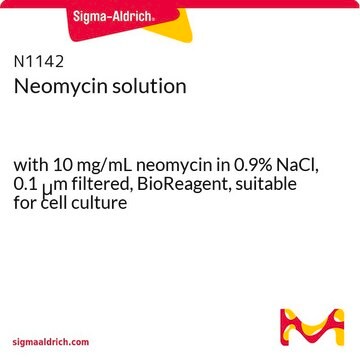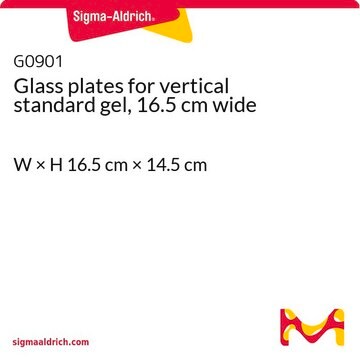G8168
G418 disulfate salt
solution, non-animal origin, suitable for cell culture, BioReagent
Synonym(s):
Antibiotic G418
Select a Size
Select a Size
About This Item
Recommended Products
Product Name
G 418 disulfate salt solution, 50 mg/mL in H2O, 0.1 μm filtered, BioReagent, suitable for cell culture
biological source
Micromonospora echinospora
Quality Level
sterility
0.1 μm filtered
product line
BioReagent
form
solution
potency
50-60 mg per mL
mol wt
692.7
packaging
pkg of 10 and 100 mL
concentration
50 mg/mL in H2O
Looking for similar products? Visit Product Comparison Guide
General description
Application
Biochem/physiol Actions
Antimicrobial Spectrum: G418 selects for cells stably transfected with an iNOS promoter construct and neomycin resistance gene and shows activity against protozoa and helminthes.
Caution
signalword
Danger
hcodes
Hazard Classifications
Resp. Sens. 1 - Skin Sens. 1
Storage Class
12 - Non Combustible Liquids
wgk_germany
WGK 3
flash_point_f
Not applicable
flash_point_c
Not applicable
Choose from one of the most recent versions:
Certificates of Analysis (COA)
Don't see the Right Version?
If you require a particular version, you can look up a specific certificate by the Lot or Batch number.
Already Own This Product?
Find documentation for the products that you have recently purchased in the Document Library.
Customers Also Viewed
Articles
Lentiviral vector systems prioritize safety features, with design precautions preventing replication. Good handling practices are essential for use.
Get tips for handling lentiviruses, optimizing experiment setup, titering lentivirus particles, and selecting helpful products for transduction.
Antibiotic kill curve is a dose response experiment in which mammalian cells are subjected to increasing amounts of selection antibiotic
Protocols
Lentivirus versions of genome modification technologies support successful CRISPR, RNAi, and ORF experiments.
FACS sorts cells based on light scattering and fluorescence for objective cell analysis.
Our team of scientists has experience in all areas of research including Life Science, Material Science, Chemical Synthesis, Chromatography, Analytical and many others.
Contact Technical Service





